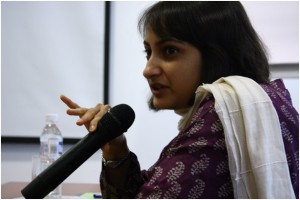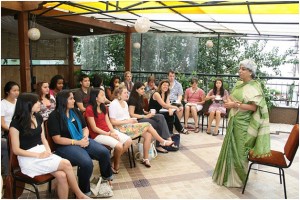Female bankers in Indian pay it forward
Guest blog post by Cate Goethals, UW Foster School of Business lecturer
Why do more women hold top banking positions in India than anywhere else in the world—including the US? My students and I went to India in September 2010 to study women’s leadership at all levels of society, including to get an answer this question.
India is a country where women are widely undervalued—a bride is burned every two hours. And where, equally counterintuitive, far fewer women go into banking, so the pool of qualified females is smaller.

Abonty Banerjee, general manager of global operations at Indian bank ICICI
Our first visit was with top female executives at ICICI Bank in Mumbai, the country’s largest private bank. ICICI has been the training ground for most of the top women in Indian banking. Why? It grew rapidly beginning with India’s economic reforms in 1991, providing opportunities for women. It also paid less than other banks and so attracted proportionately fewer men than other banks.
“We don’t do anything special for women,” says CEO Chanda Kochhar. “But we are in a way special because we don’t have any biases. When it’s an employee, we go by the merit of the employee. When it’s an entrepreneur, we go by the merit of the entrepreneur.”
Women also work harder even in an organization of hard workers, explains Abonty Banerjee, general manager for ICICI’s global operations. “We work very long hours, typically 12 hours per day, six days per week. That is a function of our population. If you don’t do it, there are so many others to fill the job.” There is no daycare, though relatives often babysit. Women are generally expected to manage households and children regardless of career. “Women succeed because they work harder at home and at work.”

Indian banker Veena Mankar discusses women in leadership with Foster students
We also visited with one of ICICI’s prominent alums, Veena Mankar. Veena founded Swahaar (“self-support” in Hindi), a bank and finance organization dedicated to making tiny loans to Mumbai’s urban poor—especially women—and teaching them how to manage money.
Inspired by the plight of her own household help, Veena is determined to make a difference in the lives of poor women. The challenge, she says, is to change their mindsets, to convince them they are as deserving as men and that their daughters as well as sons should be educated. Once they realize this, their girls often go to college, marry later, delay childbearing and have healthier children, thus ensuring a better life for future generations and the community.
This is where it comes full circle. Highly-educated and affluent women in banking use their success to change the context for women at other levels of society. “It’s not just about giving a woman a loan. It’s about giving her a place in society and her family,” explains Veena.
For background and a comparison of women in American vs. Indian banking industry, I recommend these New York Times articles: Female Bankers in India Earn Chances to Rule and Where Are the Women on Wall Street?
Cate Goethals, University of Washington Foster School of Business lecturer and Seattle consultant, leads global business seminars and study trips focused on women and international business. She has taught at the UW Foster School for more than 20 years—including a class called “Women at the Top” that was named one of the 10 most innovative MBA classes in the country by Forbes in 2010.
